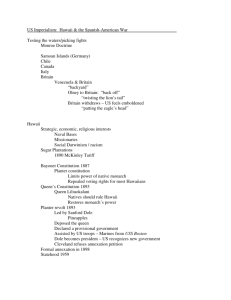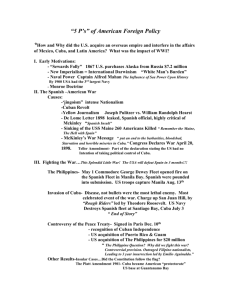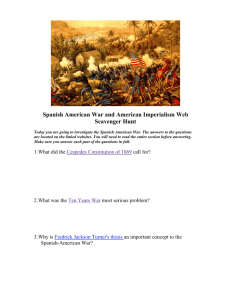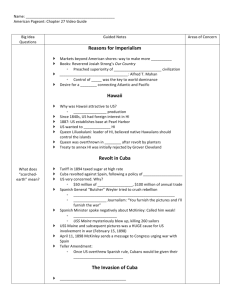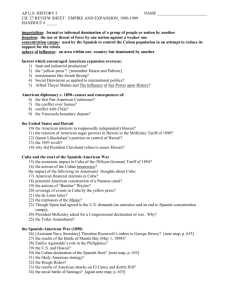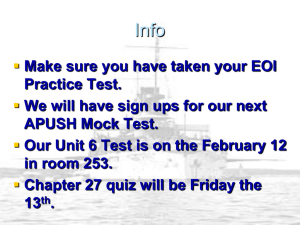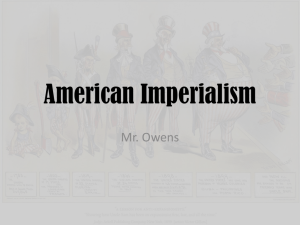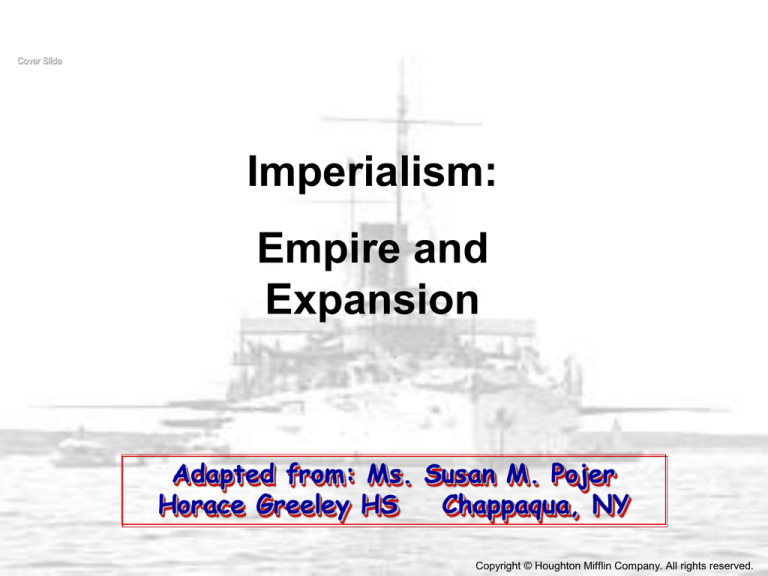
Cover Slide
Imperialism:
Empire and
Expansion
Adapted from: Ms. Susan M. Pojer
Horace Greeley HS
Chappaqua, NY
Copyright © Houghton Mifflin Company. All rights reserved.
America Turns Outward
• Background:
– End of the Civil War to the 1880s:
• US = very isolationist
– 1890s: began to expand onto the world stage, why?
• rising exports
• manufacturing capability
• power, and wealth
• overseas markets needed to sell goods
• “yellow press” or “yellow journalism” (Joseph Pulitzer and
William Randolph Hearst)
• missionaries inspired by Reverend Josiah Strong’s Our
Country: It’s Possible Future and Its Present Crisis
– Strong spoke for civilizing and Christianizing savages.
America Turns Outward
• Darwin’s influence:
– People interpreted survival-of-the-fittest to mean that
the US = the fittest
• needed to take over other nations to improve them.
• Remember: Europeans had carved up Africa and China
by this time.
• Captain Alfred Thayer Mahan’s 1890 book, The Influence
of Sea Power Upon History, 1660-1783
– argued that every successful world power once
held a great navy.
– helped start a naval race among the great powers
– moved the U.S. to naval supremacy
– motivated the U.S. to look to expanding overseas.
1. Commercial/Business
Interests
U. S. Foreign Investments: 1869-1908
1. Commercial/Business
Interests
American Foreign Trade:
1870-1914
2. Military/Strategic Interests
Alfred T. Mahan The Influence of Sea
Power on History: 1660-1783
3. Social Darwinist Thinking
The Hierarchy
of Race
The White Man’s
Burden
4. Religious/Missionary Interests
American
Missionaries
in China, 1905
5. Closing the American Frontier
Spurning the Hawaiian Pear
• From the 1820s, when the 1st U.S.
missionaries came, the US had always
liked the Hawaiian Islands
• Treaties signed in 1875 & 1887
– guaranteed commercial trade
– U.S. rights to priceless Pearl Harbor
• Hawaiian sugar=very profitable
• in 1890, the McKinley Tariff raised the
prices on this sugar, raising its price.
U. S. Missionaries in Hawaii
Imiola Church – first built in the late 1820s
U. S. View of Hawaiians
Hawaii becomes a U. S. Protectorate in 1849
by virtue of economic treaties.
Hawaiian Queen Liliuokalani
Hawaii for the
Hawaiians!
U. S. Business Interests In Hawaii
1875 – Reciprocity
Treaty
1890 – McKinley Tariff
1893 – American
businessmen backed an
uprising against Queen
Liliuokalani.
Sanford Ballard Dole
proclaims the Republic
of Hawaii in 1894.
To The Victor Belongs the Spoils
Hawaiian
Annexation
Ceremony, 1898
Cubans Rise in Revolt
• 1895--Cuba revolted agst Spain
– citing years of misrule
– Cubans torched their sugar cane fields
• hoped that such destruction would either make Spain leave
or America interfere (the American tariff of 1894 had raised
prices on it anyway)
• America supported Cuba
• situation worsened…Spanish General Valeriano
“Butcher” Weyler came to Cuba
– Tried to crush the revolt
– put many civilians into concentration camps & killed
many.
Spanish Misrule in Cuba
Cubans Rise in Revolt
• American public clamored for action,
– spurred on by the yellow press, but Cleveland
would do nothing.
• yellow press
– competed agst each other to come up w/more
sensational stories
• Hearst even sent artist Frederick Remington to
draw pictures of often-fictional atrocities
– he drew Spanish officials brutally stripping & searching
an American woman
– in reality, Spanish women, not men, did such acts.
Valeriano Weyler’s
“Reconcentration” Policy
Cubans Rise in Revolt
• Dupuy de Lôme Letter (Spanish minister to
Washington):
– February 9, 1898, ridiculed President McKinley
– published by Hearst
• February 15, 1898, the U.S. battleship
U.S.S. Maine mysteriously exploded in
Havana Harbor
– killed 260 officers & men.
– Despite an unknown cause, America was warmad and therefore Spain received the blame.
Cubans Rise in Revolt
• Hearst called down to Cuba, “You supply
the pictures, I’ll supply the story.”
• What really happened?
– an accidental explosion had basically blown
up the ship—a similar conclusion to what
Spanish investigators suggested—but
America ignored them.
• American public wanted war
• McKinley privately didn’t like war or the
• Wall Street didn’t want war because it
would upset business
“Yellow Journalism” & Jingoism
Joseph Pulitzer
William Randolph Hearst
Hearst to Frederick Remington:
You furnish the pictures,
and I’ll furnish the war!
Remember the Maine
and to Hell with Spain!
Funeral for Maine
victims in Havana
Cubans Rise in Revolt
• April 11, 1898, the president sent his war
message to Congress anyway, since:
– (1) war with Spain seemed inevitable
– (2) America had to defend democracy
– (3) opposing a war could split the Republican party
and America.
• Congress also adopted the Teller Amendment
– proclaimed that when the U.S. had overthrown
Spanish misrule, it would give the Cubans their
freedom and not conquer it.
Dewey’s May Day Victory at Manila
• On paper, at least, Spanish had
advantage over U.S.
– more troops
– a supposedly better army
– younger (& seemingly more daring)
generals
Theodore Roosevelt
Assistant Secretary
of the Navy in the
McKinley
administration.
Imperialist and
American nationalist.
Criticized President
McKinley as having
the backbone of a
chocolate éclair!
Resigns his position to
fight in Cuba.
Dewey’s May Day Victory at Manila
• August 13, 1898, American troops arrived
& captured Manila
• They collaborated w/ Filipino insurgents,
led by Emilio Aguinaldo, to overthrow the
Spanish rulers.
• On July 7, 1898, U.S. annexed Hawaii (so
that it could use the islands to support
Dewey, supposedly)
– Hawaii received full territorial status in 1900.
The Confused Invasion of Cuba
• Spanish sent warships to Cuba
• American ground troops, led by General
William R. Shafter, were ill-prepared for
combat in the tropical environment
– i.e. they had woolen long underwear
• “Rough Riders,”
– regiment of volunteers led by Theodore
Roosevelt & Colonel Leonard Wood
– rushed to Cuba & battled at El Caney stormed
up San Juan Hill.
The Confused Invasion of Cuba
• Soon afterwards--August 12, 1898
– Spain signed an armistice.
• IF the Spaniards had held out for a few
more months, they might have won
– American army was plagued w/ dysentery,
typhoid, & yellow fever
The
“Rough
Riders”
The Spanish-American War (1898):
“That Splendid Little War”
How prepared was the US for war?
The Treaty of Paris: 1898
Cuba was freed from Spanish rule.
Spain gave up Puerto Rico and the island of
Guam.
The U. S. paid Spain
$20 mil. for the
Philippines.
The U. S. becomes
an imperial power!
The American Anti-Imperialist
League
Founded in 1899.
Mark Twain, Andrew
Carnegie, William
James, and William
Jennings Bryan among
the leaders.
Campaigned against
the annexation of the
Philippines and other
acts of imperialism.
New Horizons in Two Hemispheres
• Spanish-American War lasted only 113
days:
– AFFIRMED AMERICA’S PRESENCE AS A
WORLD POWER.
– America’s actions after the war made its
German rival jealous
– Made Latin American neighbors suspicious
– Narrowed the bloody chasm b/w the U.S.
North & South, which had been formed in the
Civil War.
“Little Brown Brothers” in the Philippines
• The Filipinos had assumed that they would
receive freedom after the SpanishAmerican War
– they didn’t
– they revolted against the U.S.
– Insurrection began on February 4, 1899,
• led by Emilio Aguinaldo
– took his troops into guerrilla warfare after open combat
proved to be useless
• Stories of atrocities abounded
• rebellion was broken in 1901 when U.S. soldiers
invaded Aguinaldo’s headquarters & captured him
Emilio Aguinaldo
Leader of the Filipino
Uprising.
July 4, 1946:
Philippine independence
“Little Brown Brothers” in the Philippines
• President McKinley formed a Philippine
Commission in 1899
– deal with the Filipinos
– in its second year, the organization was
headed by William Howard Taft
• He developed a strong attachment for the Filipinos,
calling them his “little brown brothers.”
• Americans tried to assimilate the Filipinos,
– islanders resisted
– finally got their independence on July 4, 1946.
William H. Taft, 1st
Gov.-General of the Philippines
Great administrator.
The Open Door Policy
Secretary John Hay.
Give all nations equal
access to trade in China.
Guaranteed that China would NOT be taken
over by any one foreign power.
Hinging the Open Door in China
• Boxers’ Rebellion (1900)
– super-patriotic group known as the “Boxers”
revolted & took over the capital of China,
Beijing, taking all foreigners hostage,
including diplomats
– a multi-national force broke the rebellion
• powers made China pay $333 million for damages,
• U.S. eventually received $18 million
– Fearing that the European powers would
carve China up for good, now, John Hay
officially asked that China not be carved.
The Boxer Rebellion: 1900
The Peaceful Harmonious Fists.
“55 Days at Peking.”
The
Open Door
Policy
America as a Pacific Power
Imperialism or Bryanism in 1900?
• Election of 1900:
– McKinley sits on his front porch & Bryan actively &
personally campaigns
– Theodore Roosevelt’s (McKinley’s VP choice) active
campaigning took the momentum away from Bryan’s.
– Bryan’s supporters concentrated on imperialism—a bad
move
• Americans were tired of the subject
– McKinley’s supporters claimed that “Bryanism,” not
imperialism, was the problem,
• if Bryan became president, he would shake up the prosperity that
was in America at the time;
• McKinley won easily.
TR: Brandisher of the Big Stick
• William McKinley is assassinated 6 months
after election
• Theodore Roosevelt = the youngest president
ever at age 42
• TR promised to carry out McKinley’s policies.
– Born into a rich family
– graduate from Harvard
– highly energetic and spirited
– his motto = “Speak softly and carry a big stick,” or
basically, “Let your actions do the talking.”
Building the Panama Canal
• Background:
– during the Spanish-American War, the
battleship U.S.S. Oregon had been forced go
around the tip of South America to join the
fleet in Cuba
• Such a waterway would also make
defense of the recent island acquisitions
easier (i.e. Philippines, Puerto Rico,
Guam, Hawaii).
Building the Panama Canal
• U.S. negotiated a deal that would buy a 6mile-wide strip of land in Panama for $10
million and a $250,000 annual payment
– treaty was retracted by the Colombian
government, which owned Panama
– TR = furious
• wanted construction of the canal to begin before
the 1904 campaign.
Building the Panama Canal
• TR & the U.S. decided time for action
– November 3, 1903, another revolution in Panama began
with the killing of a Chinese civilian and a donkey
– when Colombia tried to stop it, the U.S., citing an 1846
treaty with Colombia, wouldn’t let the Colombian fleet
through
– Panama =recognized by the U.S.
– 15 days later, Bunau-Varilla, the Panamanian minister
despite his French nationality,
signed the Hay-Bunau-Varilla Treaty
• gave a widened (6x10 mi.) Panamanian zone to the U.S. for $15
million.
Building the Panama Canal
• 1904, construction began on the Panama Canal
– problems with landslides and sanitation occurred.
– Colonel George Washington Goethals finally organized
the workers
– Colonel William C. Gorgas exterminated yellow fever.
• When TR visited Panama in 1906, he was the first
U.S. president to leave America for foreign soil.
• canal was finally finished & opened in 1914, at a
cost of $400 million.
Panama Canal
TR in Panama
(Construction begins in
1904)
TR’s Perversion of the
Monroe Doctrine
• Latin American nations like Venezuela &
the Dominican Republic were having a
hard time paying their debts to their
European debtors
– Britain & Germany decided to send force to
South America to make the Latinos pay
TR’s Perversion of the
Monroe Doctrine
• TR feared that if European powers interfered in the
Americas to collect debts, they might then stay in
Latin America
• =blatant violation of the Monroe Doctrine
• so he issued his Roosevelt Corollary
– stated that in future cases of debt problems, the U.S. would take
over and handle any intervention in Latin America on behalf of
Europe, thus keeping Europe away & the Monroe Doctrine
intact.
• said in effect, no one could bully Latin America except the U.S.
• Corollary didn’t bear too well with Latin America, whose countries
once again felt that Uncle Sam was being overbearing.
The Roosevelt Corollary to the
Monroe Doctrine: 1905
Chronic wrongdoing… may
in America, as elsewhere,
ultimately require
intervention by some
civilized nation, and in the
Western Hemisphere the
adherence of the United
States to the Monroe
Doctrine may force the
United States, however
reluctantly, in flagrant
cases of such wrongdoing
or impotence, to the
exercise of an
international police power .
Speak Softly,
But Carry a Big Stick!
The Cares of a Growing Family
Constable of the World
Roosevelt on the World Stage
• To impress the Japanese, Roosevelt sent
his entire battleship fleet, “The Great
White Fleet,” around the world for a
tour, and it received tremendous salutes in
Latin America, New Zealand, Hawaii,
Australia, and Japan, helping relieve
tensions.
The Great White Fleet: 1907


